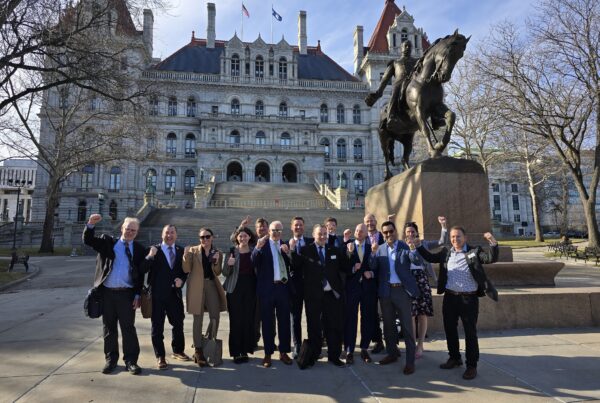As an industry, sustainability is on the precipice. Other industries still spending money to undermine the environmental lobby in 2021 are in their death throes, regardless of whether they’ve noticed it yet or not or if it takes decades for their extinction. We’re well past the notion that big business is antithetical to idealistic environmental concerns. Rather, we’re well on our way towards establishing a basic principle that economic growth and environmental sustainability are not mutually exclusive.
Take the Northvolt/Volkswagen partnership as a case study. Volkswagen signed an enormous 10-year, $14-billion battery order with Swedish startup Northvolt as part of the automotive giant’s initiative to produce 1.5 million electric vehicles by 2025. VW’s goal is to establish what Chairman Herbert Diess calls a “pole position” in the global scaling of batteries, which includes the building of six gigafactories in Europe by the end of the decade. The deal has already had a ripple effect in the EV market, as Northvolt announced it had acquired the U.S.-based startup Cuberg in order to increase the driving range of electric vehicles.
For green tech startups and sustainability industry suppliers, the VW-Northvolt partnership signals a big shift in how startups have traditionally approached attracting and doing business with big brands. Green startups shouldn’t be thinking of the big players entering the green market strictly in terms of competition, but symbiosis. It’s not that corporate America’s growing focus on sustainability is bringing bigger fish into a smaller pond—their presence in the market is helping to expand the pond.
Take the pharma or fintech industries in the late 2010s as a case study. The behemoth brands in those industries weren’t traditionally nimble enough to outmaneuver the innovations that smaller startups were bringing to consumers. The startups, however, didn’t have the infrastructure or the capital needed to make significant headway in these slow-moving, heavily regulated industries. So, how did they stay relevant? They joined forces with the giants.
Consider the biggest fintech acquisitions in recent years. The sector has seen many big consumer brand names in finance buying up small tech startups, usually adding new digital or mobile capabilities to their existing offerings. Those startups brought with them not just technical innovation, but credibility among Millennials, who still harbored a lot of distrust for large financial institutions having come of age in the wreckage of the 2008 financial crisis. The startups, in turn, got access to major resources and a seat at the table in the industry they were trying to advance and improve.
We’re about to see the same thing happen in the sustainability market. Just as we saw big banks and pharmaceutical companies embracing the changes in their industry by partnering with their fresh-faced competitors, big players in both B2B and B2C industries are setting their sights on sustainability. When big brands with resources and inherent consumer trust team up with the innovators on their turf, they create offerings greater than the sum of their parts. Many big companies have talented leadership with good foresight and, as a result, they have an uncanny ability to make strategic moves that avert mutually assured destruction.
The question is not whether big companies need to embrace new sustainable business ideas, or whether new eco-focused companies need access to their predecessors’ capital to survive. That much is self-evident. The question is how a sustainable startup figuratively paddling a rowboat can attract the notice of the ocean liners headed in the same direction.
If you’re reading a post about marketing on a blog about sustainability in PR, you likely already suspect the answer to “how?” It’s through great press and a smart earned media campaign. A tactical, impact-over-exposure focused public relations strategy can shine a spotlight on a startup for more than just their customers; a savvy PR strategy can be designed to attract buyers and partners as well. It’s all about defining purpose, building credibility, and doubling down on momentum through the power of social proof and third-party validation.
Let’s explore how startups might get in the peripherals of larger corporations to secure the partnerships, funding, and recognition they need to survive and thrive.
Sustainable Mission Statements Matter
It’s imperative for startups to position themselves as experts in the same space as the big brands they’re trying to attract. Large corporations will often pass on investments that don’t align with their products or purpose or ability to reach growing markets. Not only does a solid mission statement help make the case for your company as being purpose-driven and strategic, but it can help provide a hook for bigger companies to work with you.
Don’t assume that collaborations and partnerships can only come from high-production boardroom pitches. Even if the Fortune 500 CEO you’re wooing isn’t on Twitter, the beat reporter he reads every morning is. It wouldn’t be the first time a startup’s smart social media kit, exhibiting grassroots momentum, landed a big opportunity. Potential customers, stakeholders, and investors view mission statements as an effective embodiment of a brand’s values. The statement needs to convey a startup’s vision in a way that reassures and intrigues the public and investors.
Startups should skip over mission statements that define their products and focus on their intentions instead. This is incredibly important for startups in the sustainability sector. Small companies that have a clearly defined purpose backed up by relevant data are more likely to attract the attention of big brands. A startup doesn’t need a hefty stable of customers or millions in revenue to attract a large corporate investor. What it does need is compatibility with a big business. “If the shoe fits,” big companies are willing to invest a lot of money in early-stage startups.
The Power of Positive PR for a Sustainable Startup
Startups need to keep in mind that big businesses with staying power don’t fret as much over their competition. Instead, large public corporations are more concerned about the impact negative press may have on their reputation, stock value and shareholders, especially in this age of social media and heightened awareness around social issues.
Aside from finding mission/purpose alignment, startups that seek attention from bigger companies need to be diligent about generating positive press. Typically, a startup will only have one shot at impressing a big company. If the larger company uncovers a negative story or narrative around the fledgling business, they’re more apt to cut ties.
Aside from fostering a positive public persona to captivate attention, a sustainable startup should ensure that its products are robust and rock-solid. They should diligently manage customer relations, including responding to negative feedback, ensuring customer privacy and data security, and proactively managing legal concerns. Having products, processes, and ideas that are unique to the startup is also critical. Intellectual property attorneys will certainly present themselves if they gain a whiff of patent or IP infringement.
Proving Sustainable Products Are Actually in Demand
The COVID-19 pandemic sent the global economy into a tailspin. Understandably, many big businesses are tightening their requirements for startup financing. They want to see that a product or idea is attractive to a sizable market before they invest. Even if a startup is lucky enough to entice an early angel at a pre-revenue stage, it still needs to prove traction.
Pre-orders are a great way for early-stage startups to prove audience interest. Startups can use crowd-funding platforms like Indiegogo or KickStarter to amass pre-product sales. The more customers who are willing to put their weight behind a proposed product, the more evidence of a startup’s value and staying power. A startup can then collect the pre-order data and release their exciting news in an attention-grabbing press release.
Even if a startup can’t stockpile preorders, or their offering is more service-based, they can still demonstrate their traction by engaging with early customers. Showcasing that clients love their products and that the company is experiencing low churns will help prove a startup’s traction.
Sustainable Companies Can’t Miss the Big Picture
While some startups might have set out as the sustainable alternative and “better-for-the-environment” business to disrupt market leaders, the needle moves only when big players get on board and help generate the vast consumer interest needed for progress. Our opening story is an intriguing case study of two startups, Northvolt and Cuberg, that effectively tapped into their appealing qualities of agility and innovation, to attract a global business like Volkswagen. Startups that practice due diligence in their products, culture, and public image will be more apt to gain big partners that can help take their innovations to new heights.
Other than gaining investors, a startup’s success is largely contingent on visibility. Having a strong mission statement, generating buzz-worthy press, and using data to demonstrate consumer interest and traction will encourage bigger businesses to feel secure about investing.





